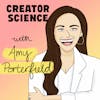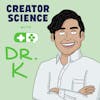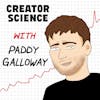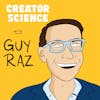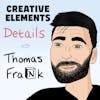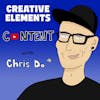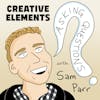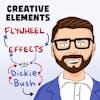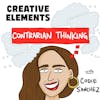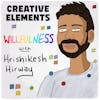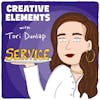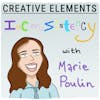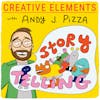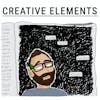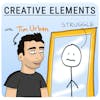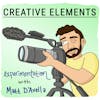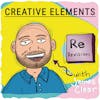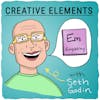
A look back at some of the gifts guests have given us this year
Do you remember watching TGIF on ABC in the 90s? They’d have new episodes of Boy Meets World, Sabrina the Teenage Witch, Two Guys, a Girl, and a Pizza Place…
And then, inevitably towards the end of the season, they’d run a clip show. Instead of running a totally new episode, they’d pull together memorable clips from the other episodes that season and stitch them altogether.
In this episode, I’m going to share with you 12 memorable clips from 12 different episodes of Creative Elements this year.
Enroll in my new course, Podcast Like The Pros
Transcript and show notes can be found here
***
LISTENER SUPPORT
Join our community on Facebook
Support this show through Buy Me A Coffee.
***
SPONSORS
Try Podia and save 15% for life as a Creative Elements listener
Start your free trial of SavvyCal and get your first month free using promo code ELEMENTS
***
ABOUT JAY CLOUSE
Subscribe to my weekly newsletter
Enroll in my course on podcasting, Podcast Like The Pros
***
PODGLOMERATE NETWORK
This show is a part of the Podglomerate network, a company that produces, distributes, and monetizes podcasts. We encourage you to visit the website and sign up for our newsletter for more information about our shows, launches, and events. For more information on how The Podglomerate treats data, please see our Privacy Policy.
Since you're listening to Creative Elements, we'd like to suggest you also try other Podglomerate shows surrounding entrepreneurship, business, and careers like Rocketship.fm and Freelance to Founder.
Learn more about your ad choices. Visit megaphone.fm/adchoices
Jay Clouse 0:01
Welcome to Creative Elements, a show where we talk to your favorite creators and learn what it takes to make a living from your art and creativity. I'm your host, Jay Clouse. Let's start the show.
Hello, welcome back to another episode of Creative Elements. About a month ago, I released the first ever solo episode of this show over Thanksgiving. This is something that I've been doing for a couple years on my other podcast Upside for weeks with national holidays often release a solo show for a change of pace. And also just to keep the episode a little bit shorter for weeks that we're probably spending with family or on vacation, and so on. So with holidays right around the corner, this week, I'm bringing you another different type of format. When I was younger, I used to watch TGIF on ABC, this was in the 90s. This is before I had cable, I just had regular broadcast television. But there be new episodes of Boy Meets World, Sabrina the Teenage Witch, Two guys, A Girl and a Pizza Place, Teen Angel. I remember being so excited for TGI F. But inevitably, towards the end of the season, they run a clip show, instead of a totally new episode, they pull together memorable clips from the other episodes that season and stitch them all together. To be honest, I didn't love clip shows, they were always a little bit of a letdown. So it's maybe a little ironic that I'm coming to you this week with a clip show of my own. But I think clip shows can actually be done in a useful way. And so I'm going to try it out. In this episode, which I'll be calling the 12 Clips of Christmas, I'm going to share with you 12 memorable clips from 12 different episodes of Creative Elements this year. These are short excerpts from conversations that have stuck with me throughout the year. Think of them like 12 little gifts that our guests have given us. And instead of playing them in chronological order, I'm going to share them with you thematically, because I think you can start to see a little bit of a pattern. And while you're listening, send me a message on Twitter or Instagram and let me know what you think. If you love it, if you hate it, I want to hear from you. But now let's get into it. Let's get to our first clip of Christmas.
First up, we have a clip from Episode 19 with Miles Beckler. Miles is an incredible writer and affiliate marketer. And our conversation focused on a theme we've heard a lot about this year, consistency. I asked Miles to validate a theory I was building about the amount of time it takes someone who is being consistent to break through. And not only did miles tell me that consistency was important. But it also came down to getting 1000 iterations. Something I'm starting to craft as sort of a theory, talking to all these people who have made it online. They talk about, you know, when they finally broke through, it seems like really the first two years of publishing is the hardest for a lot of people. And I'm curious to hear if that's your experience as well.
Miles Beckler 3:02
And I would even shorten it down I call it the chasm of death. You know, nice, gentle words, but about month three. So I just did an experiment on my channel where I started a new affiliate marketing website from zero, can I can I grow this thing to $3,000 a month within one year, but I'm too busy. So I took one of my teammates, he was already on the team to kind of project manage this. And at month three, he came to me and he said Miles, I would quit like this is the point where I would quit. We were dealing with challenge after challenge on the content on the editing, the layout, the themes, the plugins, everything was conflicting with each other. And we were seeing zero results. And we were going as fast as we could, right. This was a very intense challenge from someone who's built multiple successful brands. When I do experiments, I challenged myself aggressively. So it was a very aggressive challenge. And he literally was like I would give up at this point. So there's this point in time, when you've been publishing, publishing, publishing, you're pouring your heart and your soul into it. You're in uncharted territories here. If you're on YouTube, you're dealing with this whole, like, how do I be on camera? If you're in the world of podcasting, it's like RSS feeds. And Wait, how does that connect over there? And how do people actually find my podcasts in the world of all, or if you're on the blog, it's it's search engine Optima, it's all these little nuances that are hidden behind the process of publishing. So we're dealing with all of these learning curves, the challenges are compounding, we just want to share our talent, our soul, our creativity, whatever that is, we want to share that thing with the world. And nobody's finding it. And it feels hopeless for a period of time. But what's happening, there's two things that are going on. Number one is we're building trust with the algorithms. And it's important to think that every time we publish content, there's actually two audiences for our content. There's the algorithm on the platform that we're publishing through. And then there's the human being, and we do actually have to cater to both of them. And if we go too aggressive on either one, you're leading yourself to future problems. So some of the the scammy side of things, they'll try to find all the Google hacks and those little cheesy things they can do on Google and then A future Google update just destroys their website. Or there's people who they are absolute masters of the written craft, they are wordsmiths, they are crafting amazing written or audio or video content. But they're not taking time to understand how YouTube works or how Google works, and no one's finding their content. And that's also extremely disheartening. And so there's learning curves on both sides. And when we kind of realized that, it takes a long time to learn one learning curve, let alone two or three learning curves that we're taking on at the same time. One of the smartest things my wife and I did, we went all in on blogging, only. We didn't do blogging, and social and video and and, and, and, and, and today, there's a lot of people, a lot of gurus who get a lot of airtime that say you have to be everywhere, because everyone is everywhere and tic tocs out you gotta be on tik tok. And when Snapchat without you had to be on Snapchat, and Instagram stories, and dah, dah, dah. And I think that most actual creative, most people who bridge the gap to build a lifestyle business around their creativity, intensely go all in on one platform for long enough to get all those little learning curves down to get all of those kind of supporting muscles dialed in, then we can start to think about syndicating our content. For me, it took a year of doing nothing but videos over 300 videos in one year, just to figure it all out. And my first videos were terrible. My 30th video was not much better, but incrementally, little by little by little 1% better every day. 1% better every iteration, we get to a point where we are making an impact. And for some people that does take years there I've seen people who have gotten there in six months. But my wife and I, so we had full time jobs. When we grew ours, I would set my alarm I got up at 4:30. Every morning, I worked from 4:30 to 7:30. I was not willing to give my give the man my day job, the absolute best hours of my day. So I focused on that in the morning. And then when we got home, I worked in the evenings. And then we both worked all day, Saturday and Sunday. I didn't do barbecues, I didn't do birthday parties, I didn't do happy hours, I just I disappeared completely. And we didn't have kids. And so with that level of force, we were able to kind of bridge the gap a little quicker than some people who might only be able to put in two hours per day. I like to think it in terms of iterations, right? I think most people are 1000 iterations away from their success. So it's not hours. It's not months. It's not years, it's iteration. So how many videos can you put out how many emails how many opt in pages? How many of these little each one's an iteration? How quick can you get to 1000 is really the question.
Jay Clouse 7:27
One of the most prolific creators on the show this year it was Cat Coquilette. Cat who goes by CatCoq online is an illustrator who creates designs that are licensed for products like cell phone cases, clothes, and so on. But despite consistently creating a huge body of work, cat told me that her work follows the Pareto principle of 80, 20 80% of our revenue coming from 20% of her work.
Cat Coquillette 7:50
Mine is closer to 90, 10. So 90% of what's in my portfolio isn't really earning me that much at all. But the top 10% of my portfolio, I mean that that's pulling in the majority of my income through art licensing, ie there's a lot of factors that play here, it's creating designs that are going to be on trend that have strong purchasing power, that companies will want to license and print on their products. So it's like I've been working on finessing this every year because obviously everything I paint or that I create digitally any any of my output, I wanted to be earning me a lot of money. But there is still a little bit of a gamble. It's like, you know, I might paint something and think, Okay, this is gonna be big time. I know this is gonna do really well. And then it's just kind of fizzles. It doesn't go anywhere. And then other things I paint, for example, these alpacas that I painted after a trip down to Peru, I painted those because I loved alpacas in Peru, I wasn't painting them, because I thought that they were going to be massively on trend, which, the moment I painted them, you know, six months later, you saw pacas over every single product everywhere in every store imaginable. So that was really the right time, right place. And so you know, those alpacas alone, I mean, they earned me for a few years, probably like a 40% of my overall art licensing income. So that's one piece out of a portfolio of 1000s. You know, again, every piece I put out there, I wanted to be a big seller, a top seller, but it's a little bit of a gamble, and to see what's actually going to make it and what won't. So I do a lot of trend forecasting. And I'm looking at color palettes that are going to be really relevant. I look at New York Fashion Week, the Pantone color of the year. And I incorporate a lot of that research into the designs that I'm putting out there. I read Vogue, I listened to a lot of design podcasts, I read a lot of interior design blogs. Even though I'm not an interior designer, I still find it interesting to see the patterns that they're promoting the season. And a lot of times I can find ways that I can incorporate that into what I'm actually putting out there. So, you know, if I'm seeing a really cool wallpaper that has a lot of tropical flamingos, and all of a sudden you're, you're seeing those kind of motifs everywhere I can create my own version of tropical flamingos. It's not like I'm copying the motif with every brushstroke. But I'm taking that motif idea which is flamingos in the tropics. Adding my own spin on it, and then taking advantage of this trend that's just been skyrocketing.
Jay Clouse 10:06
A lot of creators have talked about consistency this year. And James Clear, my guest on episode number two is no exception. James is the author of atomic habits, a huge international bestseller. He told me that consistency wasn't the only important element to him, though. In fact, it's his commitment to quality and creating what he calls a plus work that has helped him to break through.
James Clear 10:28
Early on in your career, I think it's important to let the schedule drive to work, because you need to develop your voice or develop your style or consistency or whatever. Like, I think that reliability early on, and we can debate how long it is, is it a years, three years, five years, I don't know, but it for some period of time, I think there needs to be consistency, so that you can sort of like build your skills at whatever it is you're practicing. After that that period has been done, then you've kind of earned the right to think a little bit more carefully about, okay, maybe I should break the pace that I've had, so that I can do what I was talking about earlier that a plus work, so I can really make space for that. Now, there is a caveat to that, but I think can help along the way. And this is kind of how I have tried to approach my creative process, which is, I want the schedule to drive the work in the sense that I want to be reliable. I think reliability is probably one of the most underrated creative traits, especially because we often talk about creativity as something spontaneous or something that strikes you a spark. It's unpredictable, you have to kind of unearth creative genius. But reliability counts for so much, especially when it comes to building an audience. So I think that that's really crucial. However, I have this internal quality bar that I just like cannot get myself to release anything that is not good, or that I feel like has not reached a certain standard. It never feels perfect to me, it never feels good enough. But it does it like good. So the compromise that I've come to with myself is something has to get out. But I don't care how what I will compromise on is not the schedule, and not the quality, but I will compromise on the scope. And so something's got to get out of Mondays and Thursdays, that was the first three years of my career writing, I don't know how long or how short it's gonna be, maybe the best thing I can do is write one good paragraph. I don't know how I'm going to feel about it. But something's going to get out that day. And so I do still think about that, for all of the the creative projects I have now, even something like writing a tweet, any tweet that I write, it needs to be a plus work, any email that I send might be three to one might only take you two minutes to read, but it needs to be a plus work. When I work on a do a podcast interview or when I write a book, like it should be a plus work. And so each thing I put out should be excellent. Even though the scope of it might change so that I can produce on a you know, different schedule depending on you know what the speed needs to be
Jay Clouse 12:56
Backing up James idea about quality. I wanted to share this clip from Episode Six with Speaker Grant Baldwin, Grant emphasize that you can't expect professional results when treating something like a hobby.
Grant Baldwin 13:08
The less serious you take it for yourself, the less serious other people are going to take it you know, you can't say like, yeah, this is something I kind of dabble in, would you like to give me some money and I'll try it, you know, my little side project on you, like, most people aren't gonna want to take that risk. So as as much about for potential event planners, potential audiences, and you saying no, no, like, this is a legit thing. This is what I do. But also viewing it as a real thing for myself, you know, because the truth is like with anything, if you want something to be a hobby, there's nothing wrong with that, that's absolutely fine. But you can't expect professional results. If you're putting in, you know, hobby work ethic. So for example, if we fast forward to modern day, I enjoy playing golf, I'm not the best golfer at all, but I enjoy playing golf. Now I have zero aspirations to play golf professionally, I have zero skill set to be able to play golf professionally. Golf is just something that's fun to do. And so I To me, it's a hobby, it's something it's fun, I enjoy doing it with buddies. And it's a fun little competition against myself. And so because of that, I can't be disappointed when I'm not shooting like in the 60s. For the Gulf out there. Who knows, like that's really, really good. I'm not shooting like and I'm not playing on tour events, because I'm not treating it as such, right. So for anything like you can, you can be an artist, you can be a writer, you can do whatever the craft is, and have it be a part time side. Just a hobby thing that has zero business aspirations. It's just something that's fun. As long as you just recognize like that's, that's what it is. And the same thing is true of speaking, if you just want to speak a little bit here on here and there on the side. There's nothing wrong with that at all. You just have to decide that that's what you want to do. And because of that, then your expectations have to fall in line with that. So you're not disappointed at the results that you were hoping to get but the work wasn't matching up with it.
Jay Clouse 14:56
After a quick break. We'll hear what my guest said this year about building an audience. Right after this Welcome back to the 12th clips of Christmas. In Episode 21, I spoke with filmmaker and youtuber Matt D Avella. After Matt directed the hit Netflix documentary minimalism, I asked him why he took on YouTube instead of making another feature film.
Matt D'Avella 15:18
I understood then what it meant to have self reliance today, like in the digital age, and I knew that a large, large part of the success of the film, obviously amazing filmmaking, right. But then on top of that was, it was the fact that Josh and Ryan had this audience. And I, you know, you couldn't look past the fact that they had an audience that were excited and willing to pay to view their content. And I knew that there were other films I wanted to make outside of minimalism. And I didn't want to be reliant on anybody else's audience to be able to make a living and to tell the stories that I wanted to tell. And so that's where I started to think, Okay, I know that I need to build an audience. It seemed like the most impossible thing to do in the world, like, truly, I was like, you know, it just seems so unrealistic. But every time I had done that, in the past, every time I had pushed against my doubt, and I had tried something that I thought was impossible, like getting out of debt, starting a freelance film career, making a documentary, it worked out because I put myself into it fully. And I said, Alright, I'm just going to do that with this project of building and starting an audience. And also, like, I just got so much great advice personally, and also through reading blogs, and books, and I read everything you could on entrepreneurship, and building and growing an audience. And I'm like, I know all the things, I need to actually put it into action now and just give myself two to three years and say, Okay, I'm just going to dedicate myself for this period of time, no matter what, through the face of failure, doubt, and all the other like negative things that happen during those early periods of time, and just push through, and kind of just look towards that finish line, as opposed to looking at those short term failures.
Jay Clouse 17:05
And speaking of building an audience, that brings me to Episode 10, where I spoke with another YouTuber, Amy Landino, what really stands out to me about this conversation is that Amy really stressed the importance of knowing who you are creating for if you're going to be building an audience.
Amy Landino 17:22
The only thing that matters, literally the only thing because niche is an important word, right? We talk about this a lot in business niche, niche, niche, whatever you want to call it. We want to talk about what our that that so not the same today, as it used to be our niche today is just like basically who we are and what we stand for. So with that being said, not worrying about category not worrying about exactly like what is the best thing to talk about? Who are you doing this for? Like? That is all of it. Let me tell you the reason why I've always felt success. When I watch a video, at least once these days, it's more like 50 times. I get the the comment. Oh my god, how did you know I needed this video right now. Or I feel you made this video just for me. That should be the goal every time. The only way that happens is for you to know somebody really well. And Jay if I've been going to coffee with you every Wednesday for a long time, you get to know each other. You may not know each other very well on that first trip. Maybe not the second one. But as you continue to find out, okay, I posted something let's see what happens. Nothing. Okay. Well, there's there's that's a start, we got nothing. The next time you get a couple comments, they probably have question marks on the end. What are the questions have to say? What loops did you not close? That's not only fodder for content next time you're learning what they're thinking about. The more you learn about what people are thinking about psychology, hacking, you're starting to understand these people so well, that I don't look at the lens of a camera. I talked to a woman named Charlotte, I know her very well. And it's who I talk to in everything I do, because she believes in going after the life that she wants. And that's what we talk about. And I talk about anything that would apply in her life in that capacity. Now, I have lots of people named Joe in their 50s that are not Charlotte, okay, and they want to make it for Joe. No, not making it for Joe. But every once in a while Joe's stoked about a video cool. That's the reason why content works is because you do it for the core, and then it ripples out. shareable stuff is shareable for everybody. And if it just so happened to be great for Joe's day, because it struck a chord that's going on in his life. That's awesome. He might come back to the channel and go, well, none of this other stuff makes sense to me. But that was really good. He's gonna think about a Charlotte in his life that should maybe watch the channel. That's the most important thing in the world. The best creators know who they're talking to. They know the type of humor they'd like. They know The amount of curse words that would make sense. They know the video titles that are going to get their attention. They know the the season that they're in. Right now we're all in the same season. Ironically, at this very moment, this is super interesting. And it's why there's the same word in every single email, blog post video everywhere right now, because we know what season everyone's in at the moment. It's knowing that person so that when you show up, you don't sound like you didn't do your homework that day, or that you don't care about the person and aren't even genuinely curious about them. I think genuine curiosity and having the audacity to say, I know exactly who my person is, there's one type of client that would buy my service, that would be the best client ever. Those are the people we're looking for. Those are the people we make videos for. And therefore, we can find them every single time they'll find us, they will gravitate toward us. And we're going to help other people in the process. But if you don't have that core 1000 fans or whatever that epic blog post here 1000 true fans, that's what you should be focusing on. That's the big goal. If you have 1000, true fans you can make you can move mountains in your life and build something. But we're too busy thinking about the millions and the viral, or that we're sitting here talking to ourselves in a room by you know, and feeling judged of ourselves, or the wrong people who are going to watch our stuff, or our friends who are going to think we're weird. Like that's what I had to deal with 12 years ago. And I know a lot of people still deal with that, because it's still a big venture to get on camera. You solve all those problems when you prioritize the person you're doing it for.
Jay Clouse 21:34
And not only do you need to know who you are making things for, but you need to understand how they think. In Episode 28, I spoke with travel hacker and blogger Bryce Conway, Bryce had written an E book to help people learn the ropes of travel hacking, and even secured a spot on primetime television. He expected that this appearance would result in 1000s, of sales of his ebook, but it turned out to be a total flop. And he told me that it came down to not understanding how to frame his message to his audience.
Bryce Conway 22:04
I think it all comes down to a lack of understanding of the way that people think, particularly about like my product in this particular space. So I've been in points and miles and like, you know, free travel, if you will, for years at that point, so it wasn't uncommon for me to talk some like, Hey, you know, you can actually travel for almost free by doing these couple simple things. And I'm used to if you've been like, yep, like, here's how it works. But I was disconnected from the average person, which naturally when you walk up to him, like, Hey, you can travel basically for free by doing a couple simple things. The natural reaction is, okay, like, you know, what are you selling? Is this an MLM? Am I gonna go to jail? You know, most people are totally scaffold weapons kind of thing. It which is a totally natural, but I was approaching it from a logical standpoint, I was like, Hey, I have this clear sales pitch, if you buy this book for $49, I promise you, you're going to get at least a free flight, what rational actor wouldn't jump at that. And that was my mindset at the time. And what I've learned, and what that really ingrained in me is, sales. And a lot of just life is emotion. It's people feeling good about what they're buying, it's people believing that they can trust you. And when you come at it with this, this type of rational, this is a no brainer, can't miss thing, you totally missed the thinking that's going on with your potential customers.
Jay Clouse 23:22
So if you were sitting down with Bryce from six years ago, and he tells you, I'm going to sell an E book for $49, and forgetting that at 2020, and people don't sell ebooks all that much. Back in 2014, he says, I'm going to sell an E book for $50. And you have this insight about emotion. What type of direction would you give that person for actually trying to sell this product based on emotion as opposed to logic,
Bryce Conway 23:44
I would say you have to do a lot of research to very deeply understand the way that your potential customers think it's not, the pitch is not you can fly for free, right? Read that and blow right past it, it's, we can save you a substantial amount of money on your bachelor party. Or we can help you take a honeymoon that you didn't think you could afford. You put it in the sense that the way that people are already thinking and in a way that they view is approachable. And then that kind of starts and down the path. And from there, it's a longer education process. But if you just come out and kind of like that hard, like, you know, you're giving me $5 and giving you $10 back, like what's to miss versus find what they're actually thinking about, like their hopes, fears and dreams is what a lot of people call it and write it in a way that really hits on those to get them interested.
Jay Clouse 24:33
When we come back, we explore the pros and cons of being your authentic self. So stick around and we'll be right back. Welcome back to the 12th Clips of Christmas. One of my most popular episodes this year was episode number 30. With writer and neuroscience students on Anne-Laure Le Cunff. Anne-Laure's story is so great because she has built her audience very recently. She didn't set out to build an audience initially, but she soon realized that her commitment to writing could be leveraged to attract readers, and it was her authenticity that made it happen.
Anne-Laure Le Cunff 25:04
Pretty early on I, I think after a few weeks, I wrote for a few weeks. So at the time, I gave myself a challenge of writing five articles a week, until I reached 100 articles. And I think after something like five weeks, 20 articles, I already had a few 1000 subscribers. I was like, Whoa, man, there's something here. Interesting. And as I okay, I could either just keep on doing what I'm doing and being passive about it, or I could be a little bit more productive. And from that point on, I always made sure that I would post new articles on Twitter, on various platforms where I knew knowledge workers and creators were hanging out. So it became a bit more of a proactive process. I've never, though I really applied any of my true marketing skills to this. If I was an employee, or it concur ness labs and being purely in charge of marketing, I would do so much more. There's so many things that I can do. But as of now, the part of the process I enjoyed the most is do research and the writing. And so I do the bare minimum for marketing, but I still do it. And I only started doing the bare minimum a few weeks and
Jay Clouse 26:22
How much of that research is a direct result of your studies versus you branching out and saying, I'm learning about this, because I want to be learning about this and writing about it
Anne-Laure Le Cunff 26:30
It has shifted a lot in the first few months, it was probably 80% based on what I was studying at uni. And now I think it's probably 20% stuff I study at uni and 80% stuff that probably my curiosity about it probably started somewhere stems from something I studied at some point IV, but I've started branching out so much in different directions that I'm curious about, you know, when you fall into Wikipedia, and black holes of just say, yeah, content. And so that is that's what's been happening, and and now there's much more I write about that it's just the result of my own personal curiosity versus stuff that I'm being taught in uni.
Jay Clouse 27:13
I can hear my audience, just like screaming, ask her how ask her how this actually happened. So when you put up this this page, I assume instead, I'm writing about this, and people started subscribing and mass. What was the what was the hook that pulled people in? Or what are some of the mechanisms that are actually getting people to say, here's my email,
Anne-Laure Le Cunff 27:31
I think one very important thing was that I was very transparent in terms of what people would get. I was saying, Hey, this is me, I'm a student. I'm not an expert. I'm learning this, and I'm just going to share it with you as I go. And I've heard lots of good feedback about that, where people always say, it felt really welcoming, versus intimidating. I was like, Oh, that's awesome. I am also students, everyone is a student, when you think about it, I'm curious about this. And instead of having this expert talking down on you, you feel like your fellow students learning together. So that was one thing that I got really good feedback on the right thing help people give me their email address. Second thing is the consistency. I've had people, it's a bit meta, but I was writing about creativity and productivity, while demonstrating how everything I was writing about works, in my case. So you hear and read or watch videos from lots of productivity gurus online, where you're like, Okay, cool, but does it actually work? Do you actually use what you preach? Or are you just trying to sell me an expensive course or something. And I think in my case, I was both writing about these topics, and demonstrating everyday by showing up by writing five articles a week by sending a weekly newsletter by engaging with the community, that what I was preaching could actually work. So I think those were the two main things the which both when I think about it, they both fall under the umbrella of authenticity, I was authentic, both in terms of contracts, and saying, This is what you can expect them, this is who I am, and I'm not trying to pretend I'm more of an expert than I am. And being authentic in the sense of saying whatever I write about whatever advice I give you, um, as the CEO of Google, I'm eating my own dog food.
Jay Clouse 29:30
And so now I have to come back to episode one. In my interview with Seth Godin, we just heard from Anne-Laure how important authenticity was to her ability to build an audience. But in my conversation with Seth, he actually told me that he thinks authenticity is overrated. And in order to consistently deliver on what people need from you, you need to be a little inauthentic and think about your personal brand.
Seth Godin 29:52
Well. So let's start with this. A brand is not a logo. A brand is something else. A brand is a set of promises and exhibition. Expectations that people have about something they're about to engage with, that they wouldn't have had if you were generic. So I would argue every human on Earth is either a brand to someone, or invisible. Those are the only two choices. So if you every day on your way to work in Mumbai, pass a tea vendor on the corner, he or she has a brand, because they're going to act the same way every time you meet them. That's what you expect. Otherwise, we'd never be able to process all the incoming in our life, we process it, because we can ignore most of it. So you have a brand? That's not the question. The question is, is it the brand you want. And if you want to make it the brand you want, that's going to take some effort. Now you could say my brand is however, the way I feel today, I'll say whatever pops into my head. And if you do that, then you become one of those cranky old men on YouTube are spouting off about stuff that no one wants to hear. But for the rest of us, the same way that Nike or Western Union, or Uber has a brand and that on a good day, they stay on brand. As humans, we can do the same thing. What does it sound like when we sound like us? Well, you should try to sound like that.
Jay Clouse 31:14
How much do you think about that for you? And what does that process sound like?
Seth Godin 31:19
Oh, I think about it all the time. And, you know, I can't even remember which airline their slogan was, we really like to fly and it shows. Well, I would really prefer to fly at an airline and people who say, it's our job to fly you there safely without annoying you every time. Because I don't want my experience to be based on whether you like flying or not, not my problem.
Jay Clouse 31:44
So now that we've talked about consistency and what it takes to appeal to an audience, let's hear from Vanessa Van Edwards, my guest in Episode 11, about growth. Vanessa is the creator of science of people, author of the best selling book Captivate, and her blog is read by millions of readers. Vanessa told me that her key to growth has actually been leveraging other platforms.
Vanessa Van Edwards 32:05
Leveraging other platforms has been a really important piece of our business growth. So search is a foundation. So I barely even want to touch on that. Because it's so important that it's the foundation. Yes, you need to make sure that everything you do is optimized for what people actually want, which is what are they searching for? That's a foundation. The second thing is leveraging other people's platforms and pivoting for them. So very early on, my husband was so grateful for him. He said, hey, there's this course platform called Udemy. You know, they do like a lot of software courses and accounting courses and spreadsheet courses. But I bet you they would love a body language course. I was like, Okay, and so I'm looking at you to me, and I'm looking at their audience and their audiences at that time was very technical, a lot of engineers and so I thought I'm going to do a business body language course for these folks. A little pivot for me, that was not what I was writing about originally. So like I pivoted into, okay, what would the perfect course for you to me be. And I took my iPhone and I filmed a course on my iPhone in my kitchen. With all my lamps in my apartment. I dragged them over to the kitchen, I didn't have festival lights, I didn't even have personal microphone, I was using my phone,
Jay Clouse 33:20
And it's probably like an iPhone five.
Vanessa Van Edwards 33:22
At the most. at the most. Film Of course. I'm like, if I can get 30 sales, I will be so excited. And I think at the at the time it was priced at $49. So I can get 30 sales, I will just be thrilled. So I put the course up and it took I think 1224 hours for the course to get approved by Udemy. I put the course up I go to sleep I wake up the next morning and I will never forget my inbox was filled with sales. Like for as far as the eye could see with sales. We have 278,000 students on Udemy right now.
Jay Clouse 34:03
Speaking of success with online courses. Next up is Ran Segall my guest in Episode Number 27. as your business grows, sometimes it demands things from you that may not be your favorite thing to do. That came up in this conversation with Ron, a designer YouTuber and creator of Flux Academy. Ran's first course the Web Flow Masterclass, was really successful. And he told me that it was successful because he spent years creating on YouTube without asking people for a single dollar. And now that Flux Academy has gotten traction, he finds himself spending more and more time thinking strategically about growing the business as opposed to just creating what's interesting to him today. The thing that got him where he is, this got a little touchy, but I wanted to dig into why he felt he needed to get strategic now, if that's not what got him to this point. I'm wondering you know, you're talking about you've hired eight people and now you're chasing these metrics and that's affecting how you're creating certain content. The masterclass worked because you did the videos To your style the way you wanted to do for years, and you said, Hey, I made this thing. So why why not just continue down that same path continuing to make the videos that you want to make and saying, Hey, I made a thing, what decision did you make to say, I want to focus on growth?
Ran Segall 35:15
No, I don't think that the focus is on growth, I think that the focus is doing the best thing. And I don't think the first version that I did was the best, it was the fastest thing that I could do to deliver on my promise, it was not the best. And I can already tell you that even version two that we have right now, I have a lot of ideas on and we will do version three next year. Because I can see a lot of and we're working on version two of the different course that we have right now. Because I don't believe anything is perfect, and I want to make it better. It's not about growth as making more money, I want to make sure that my courses deliver more value and actually help people get the results they need as fast as possible.
Jay Clouse 36:00
And then more of like the the general YouTube content that you're creating. Now you're putting a lot of strategy behind it, why not just continue with what you wanted to make week to week, as opposed to looking for, you know, keywords and things like that.
Ran Segall 36:14
I think what I wanted to change, you know, I don't want to do a daily vlogging anymore. I'm not interested, I wanted to explore that. I explored that for two and a half years. I don't want to do it anymore. I mean, it's that's not interesting or exciting for me right now. It's not like I want to go back to something else. You know, maybe if I am looking at, you know, what am I excited about? Then maybe me perhaps I'll open up a podcast because I like talking to people? Well, there's a lot of things you're Yeah, we're exploring. Yeah, we'll have to, but we have to. But now I'm looking at this from a more balanced perspective, it's not about just what I want. It is important to keep in mind what I want. Obviously, I am building a business. I don't want to build a business business I hate. But we need to take a balanced view of what's good for the business and what I want and find some kind of a balance there.
Jay Clouse 37:12
Yeah, that's kind of what I was trying to get to. Because I think a lot of people, they start to find success in one direction or another. It could be with client work. And they think, all right now I just need more of that. And sometimes I question to myself, like more, to what end, you know, when is more enough? And if it if it starts to threaten my relationship to the thing, I could see where I might think, do I want more? I don't know. And I wondered if you'd struggle with that.
Ran Segall 37:37
I'll give you the different perspective is I know about myself that I get bored easily. If I would only do what I want, I stopped doing YouTube, I move away and just move away. I'm a designer, I like to create things from scratch, I'd like to move on to the next thing. If I keep that pattern. That's not a very healthy pattern to grow a business and build something meaningful. So I need to and luckily, I work with a business coach who keeps me in line. And that's, that's really good. Because if I would be left to my own devices, I would just move on to the next thing, right? Keep doing what I'm passionate about. But when you when you're doing that, you know you might be limiting yourself from building something that you also want.
Jay Clouse 38:26
Okay, you've made it to the 12th and final Clip of Christmas. And this comes from Episode Number 23. With negotiation expert Kwame Christian, this is the most popular episode of the year and spoiler, I'll be re airing it in full next week. hearing all of these clips from these creators may have your head spinning with a lot of new ideas for your own business. But having a lot of new ideas can sometimes feel a little bit overwhelming. Kwame is one of those guys who just seems to get it all done. So when I talk to Kwame, I asked him how he managed to keep the ball rolling on so many projects at once.
Kwame Christian 38:59
It's tough, it's really tough. And again, that's that there's a bit of maturity that comes with the philosophy of time management as well. And I needed to make sure that I made space for the things that are important. One of the things that I like the visual that I keep in mind is that it's a juggling act, everybody's juggling. And so as you're juggling, you put more balls in the air, right, as you take on more responsibility to put more balls in the air. The thing that people don't recognize is that some balls are rubber, some are glass, some balls you drop, and then they can't be fixed. Other balls can bounce back. And so what I've become really focused on is that with my family, I can't drop that ball. I'm not going to do that type of damage. But when it comes to the other stuff like work related stuff, I can drop those balls they'll be they'll bounce back. And I think there needs to be a little bit of grace and self compassion when it comes to this because we have these we look up to some of these people. And we they say oh yeah, I work 80 hours a week and then I do this. And then I do that, why? Because I have to because I want to be great. It's like, Whoa, you're not a person like that. And first of all, that might not even be who you are. And now I realize that I am the kind of person that I would have looked up to in 2016. And understanding what my day to day is. Now, it's very different from what I thought it was going to be, because I thought I had to turn myself into a machine. But that's not realistic, it's not possible. And when you consider self care, I mean, you're gonna burn yourself out. And I think a lot of people are burning out because they're doing it the wrong way. I just finished a book called 80, 20, the Pareto principle. And I think everybody has a basic understanding about the idea that 20% of your inputs will lead to 80% of your outputs. So for instance, 80% of your revenue is going to come from 20% of your great clients, and we have a decent understanding about it. But going into that book made me feel like I've never heard the principle before he went into such a level of depth. And it made me realize that even in the midst of this pandemic, because of my willingness to pivot and focus on those highly leveraged activities, I was able to right now the business in a place that's better than it was beforehand. And I was really concerned because everything I did was focused on me getting on a plane and giving trainings across the country. And then that was taken away. I'm like, how am I going to figure this out, but slowing down and making sure that I'm doing the right things was the key. And so here's the thing, thinking about things that are going to slip through the cracks. I've never been more behind on email. I've never been more behind on LinkedIn messages. And all of these things everybody's trying to vie for my attention. And what I would do is I would go outside, take a leisurely walk, and just focus myself and say, What will I care about in five years? Will I care that I sent this email back about this bad business opportunity? No, I won't. I'll forget this. I will forget this. But what will I care about that I would do? And then I would do those things. And so Jay, here's the thing, I stopped doing a to do list, and I stopped doing random things, I will slow down and walk around the community until I know the most valuable thing to do for the day. And then I'm just going to do that one thing, and everything else will drop. And some of those balls are going to be glass, but then you recognize that the ball some of the balls that you were trying to juggle, were not important at all. So you just need to be more strategic about the things you can and should not do. I think that's the key because we live in a time where buisiness is like a badge of honor. It's not necessary. Are you being busy? Are you being productive? I think that's one of the questions we have to ask ourselves.
Jay Clouse 42:35
That is it for our 12 clips of Christmas. If you like this clip show, find me on Twitter or Instagram @JayClouse and let me know if you hated it. I want to hear that too. Don't let me get away with making things that you hate. I hope you spend some time this week to relax, reflect and connect with your loved ones because it's been a really tough year and I'm sure that you could use a break. Thank you to Brian Skeel for making the music to the show. Thank you to Nathan Todhunter for mixing the show. And thank you to Emily Clouse for greeting the artwork for this episode. If you love Creative Elements, the best gift you could get me this year is a rating or review on Apple podcasts seriously, it means a lot. Otherwise, thanks for listening, and I'll talk to you next week.
Most Popular Episodes
New to the show? Check out some of our most popular episodes.






